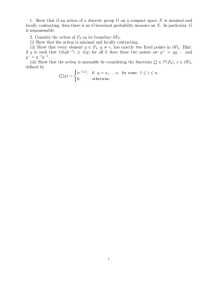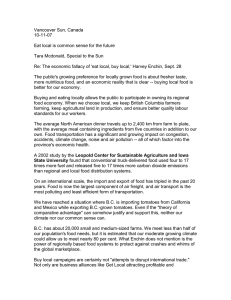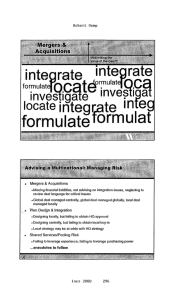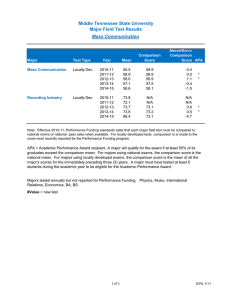N O T E O N ... P R O D U C T A N D
advertisement
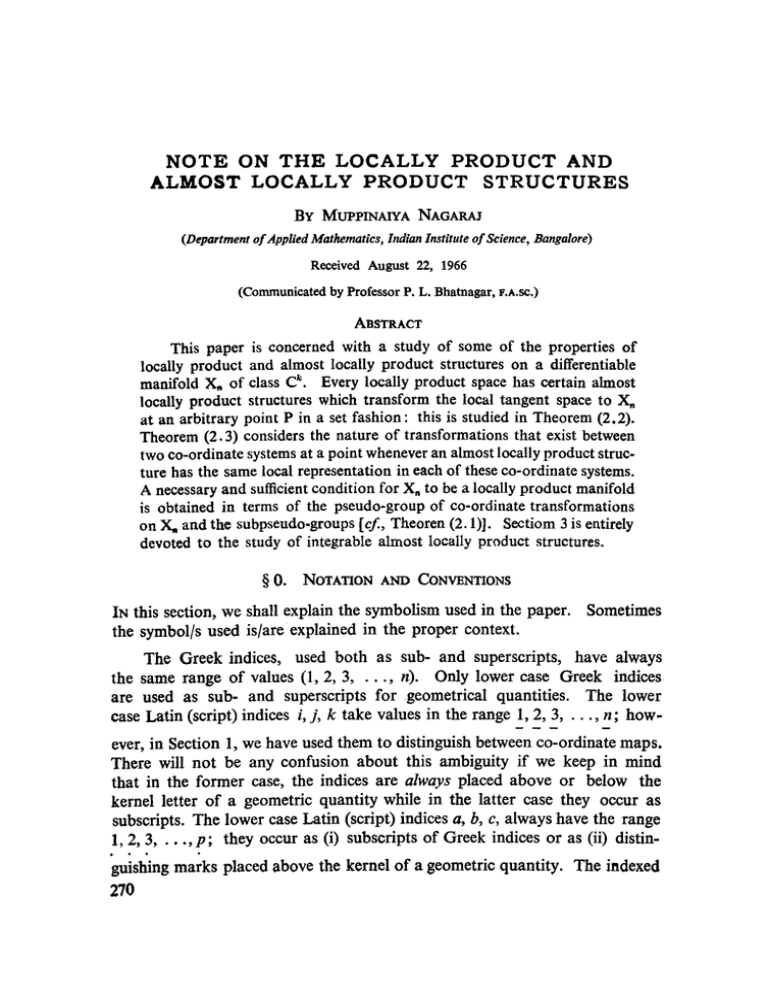
NOTE ON THE LOCALLY PRODUCT AND ALMOST LOCALLY PRODUCT STRUCTURES BY MUPPINA1YA NAGARAJ (Department of Applied Mathematics, Indian Institute of Science, Bangalore) Received August 22, 1966 (Communicated by Professor P. L. Bhatnagar, F.A.Se.) ABSTRACT This paper is concerned with a study of some of the properties of locally product and almost locally product structures on a differentiable manifold X, of class C ~. Every locally product space has certain almost locally product structures which transform the local tangent space to X, at ah arbitrary point P in a set fashion: this is studied in Theorem (2.2). Theorem (2.3) considers the nature of transformations that exist between two eo-ordinate systems at a point whenever ala almost locally product strueture has the same local representation in each of these co-ordinate systems. A necessary and sutticient condition for X, to be a locally product manifold is obtained in terms of the pseudo-group of co-ordinate transformations on X~ and the subpseudo-groups [cf., Theoren (2.1)]. Sectiom 3 is erttirely devoted to the study of integrable almost locally product struetures. w 0. NOTATION AND CONVENTION$ IN this section, we shall explain the symbolism used in the paper. the symbol/s used is/are explained in the proper context. Sometimes The Greek indices, used both as sub- and superscripts, have always the same range of values (1, 2, 3, . . . , n). Only lower case Greek indices are used as sub- and superseripts for geometrieal quantities. The lower case Latin (script) indices i, j, k take values in the range 1, 2, 3, . . . . n; however, in Section 1, we have used them to distinguish between co-ordinate maps. There will not be any eonfusion about this ambiguity if we keep in mind that in the former case, the indices are always placed above or below the kernel letter of a geometric quantity while in the latter case they occur as subscripts. The lower case Latin (script) indices a, b, c, always have the range 1, 2, 3, . . . , p ; they occur as (i) subseripts of Greek indices o r a s (ii) distin"guishing marks placed above the kernel of a geometric quantity. The indexed 270 Note on Locally Product and Ahnost Locally Product Structures 271 Greek sub- or superscripts Aa, b91 etc., take values in the range ma-1 + 1, ma-1 + 2, . . . . ma, where we have ma-1 : ni + n2 + 9 + na-1 for each value of a, mo = 0 and m.~ = n. The summation convention applies only to Greek indices, whether further indexed by a,_b or e, of not. indices do not follow the summation convention. The Latin The symbol • is used to denote the tensor product of two geometrieal quantities. It is also used to denote the tensor products of linear spaces. w 1. LOCALLYPRODUCT AND ALMOST LOCALLY PRODUCT STRUCTURES In this section we shall study some definitions bas'c to our work. The locaUy product and the almost locally product structures will be defined globally. Definition (1.1 a).--Let Xn denote ah n-dimensional real differentiable manifold of class C k (k ~> 2) and let it be possible to cover Xn by a system of co-ordinate neighbourhoods (Ui, ~91 such that the following conditions hold: (i) The indexing set I is countable and Xn = u (Ui). (ii) For any two co-ordinate neighbourhoods (Ui, 6i) and (Uj, 6j) which ate not disjoint, i.e., Ui N Uj # O, the map 6j. ~911: 6i (Ui r~ Uj) --~ 6j (Ui n Uj) is a diffeomorphism of class C ~:. This diffeomorphism has a non-singular Jacobian matrix of the form (J~j. ~,-~) ----diag. ((Mnl, Mn,, Mn~, . . . , Mn~)). (1.1) [H•re Mn~ is a real non-singular matrix with na rows and columns for each P a = 1, 2, 3, . . . . p and Z' (na) = n.] Then we say that the system of co-ordi9 9 9 9 nato neighbourhoods (Ui, t~i)i,! defines a locally product structure of order p and characteristic (n~, n2, n3, . . . , np). The differentiable manifold endowed with such a structure will be called a locally product manifold, its order and charactefistic being the same as those of the locaUy product structure. A co-ordinate system belonging to a locally product structure has pleasant properties. We use such a co-ordinate system in the following. Definition (1.1 b).--Let a differentiable manifold admita locally product structure. Any co-ordinate system belonging to such a structure is called a canonical co-ordinate system. 272 MUPPINAIYA NAGARAJ The concept of a canonical co-ordinate system is due to T. Y. Thomas6 (seew In the next section it will be shown that there exists in every locally product space a quadratic tensar Tx~' of rank n which satisfies the following two properties: (i) In a canonical co-ordinate system, the tensor T has constant components, and (ii) ir satis¡ the following equation at each point of the manifold: Tx~'T~" = 8x'. (1.2) In the sense of property (i), the tensor T is canonical to a locaUy product manifold. (1.2) wiU now be used to define a new type of structure on a differentiable manifold: Definition (1.2).--Let a tensor field Tx~ of rank n satisfying (1.2) be defined at each point of a differentiable manifold. Then such a tensor field is called an almost locally product structure on the manifold. Every differentiable manifold Xn admits an infinity of almost locally product structures. For there always exists an infinite number of sets of n linearly independent local cross-sections (u) of the tangent bundle T (Xn) and the corresponding sets of n linearty independent (dual) local cross-sections i (u) of the cotangent bundle T* (Xn). If P i s a generic point of X~ and (x) is a local coordinate system at P, then u and u have the following local representations: u=uX( ~) , ~x (1.3 a) u -----Ux (dxX). (1.3 b) Since u and u are dual local cross-sections, we have at P, J UXUx= 8ii s ~ Z' (UxU~) = 8xa. 1 (1.3 c) (1.3 d) i It is easy to see that Z' ~i (u t~ u)is a local section of the tensor bundle (T ~ T*) (Xn), whcrr the fibre above ah arbitrary point P o f X n is the vector s p a ~ Tn(P) Note on Locally Product and Almost Locally Product Structures 273 "In* (P) (~i=-4-1). As a global consequence of (1.3 cd), we obtain at once the fact that the square of ~ ~/i (u | ª is the unit cross-section I of (T @ T*) (Xn). Thus we see that there are an infinity of almost locally product structures on a differentiable manifold Xn. We end this section with a few bibliographical comments. The concept of a locally product structure has been studied by F. A. Ficken, ~ J. A. Sch~uten5 (pp. 285-287), T. Y. Thomas, n K. Yano 7 (Chapter X), etc. A product space has been utilized by V. Hlavaty in his work on the Unified Field Theory of Einstein 4 (cf. w 6, Chapter III). In the present work, the definitions of locally product and almost locaUy product structures are along the lines followed by Alfred Fr61icher who defined the complex and almost complex structures globally. He also brought forth the close relation between these two structures (cf. A. Fr61icher, ~ pp. 53-55). However, the generality in our definition has been motivated by the results of V. Hlavat'y on almost complex spaces (of. V. HlavatyS). K. Yano deals extensively with the locally product and almost locally product spaces in bis book 7 (see Chapters X and XI; here the reader could find further references to the work in this direction). w2. PROPERTIES OF LOCALLY PRODUCT AND ALMOSW LOCALLY PRODUCT STRUCTURES Let Xn be a locally product manifold of class C ~, order p and characteristic (ni, n~, nz, . . . , np). The locally product structure on the manifold splits the local tangent space Tn (P) a t a generic point P of the manifold into p distinct subspaces Tno of dimension na. The Jacobian matrix of co-ordinate transformations at P have the forro (1.1) whenever the local co-ordinates are canonical to the structure. Then in suela a case the Jacobian acts on Tn (P) so that Mn,, and norte else, operates on the subspace "['na. Further, the totality of all canonical co-ordinate systems are sucia that for any two members (U, x) and (V, y), U n V :/= O, xn'~C k [U el V] and ate independent, for b =/= a, of yng. Hence if the pseudo-group of co-ordinate transformations for Xn is Pn, ir contains the direct product (Pnl • Pn, x . . . x Pn,) of the p subpseudo-groups Pna. Conversely, ir is obvious that Xn is a locaUy product manifold whenever the pseudo-group Pn of co-ordinate transformations of Xn contains the direct product of P sub-pseudo-groups P,t,. Then the order and characteristic of the locally product structure on Xn are respectively p and (ni, n~, n3, 9 9 np). Summarizing these results, we have the following: 274 MUPPINAIYA NAGARAJ Theorem (2.1).--A necessary and sujO~cient condition f o r a differentiable manifoM Xn to admita locaily product structure is: The pseudo-group Pn of co-ordinate transformations contains the direct product of the p subpseudo. groups Fn,. I f these conditions are satisfied, the locally product structure is of order p and characteristic (ni, n2, n3, 9 9 np). Now we shaU define a canonical base for the local (co-) tangent space (Tn* (P)) Tn (P) a t a generic point P of a locally product space. A similar base has already been used in our work (see the discussion immediately preceding the bibliographical comments of w 1). Definition (2.1).--Let Xn be a locally product manifold of class C k, order p and characteristic (ni, n~, n3, . . . . np). If (x) is a local canonical coordinate system at a generic point P of the manifold, then ~x~l ' ~xa,' ~x~, ' " " "' ~ ; x constitutes a base for the local tangent space Ta (P) at P. Similarly (dxX,, dxX,, . . . , dxX,) constitutes a base for the local cotangent space Ta* (P). These two bases are called local canonical bases for Ta (P) and Ta* (P). Let Xn be a locaUy product manifold of class C k, order p and characteristic (ni, n2, n3. . . . , np). Define the linear map J: Ta (P) ~ Ta (P) as follows: On a canonical base (~/~xx) at P, J ( ~~ ) = Ta ( ~~ ) (r/a = q- 1)' (2.1 a) It is easily seen that J is an endomorphism of "In (P). It is a simple matter to verify that J induces on Tn* (P) a unique endomorphism J* such that the foUowing hold: J* (dxx~ = ~adxXo. (2.1 b) Now let (x) and (y) be two canonical co-ordinate systems. Affect the co-ordinate transformation (x) ~ (y). Then ((~~/~xX)) and ((~x~'/~yX)) are of the forro (1 : 1). ( ( ~ ) ) = ~~~~.((~., ~.,, ~., ..., ~.,)) bx~ (2.2 a) (2.26) Note on Locally Product and Almost Locally Product Structures 275 where = ( ( ~y~'~ k\~xX,]] (2.2 c) Nn, = \\-~-~-11 (2.2 d) Mn, are n a • na matrices. The canonical bases for Tn (P) and "In* (P) transform according to the following: ~~. , ~ j ( ~ ) (2.2 e) (2.2f) [bX#,X . . dx~, = [ , ~ ) ay^. (2.2 g) [ by~', X , . ay,, = k~-~~-,] ax,,,. (2.2 h) Because of (2.1 ab), (2.2 e-h) and the linearity of J and J* we have the foUowing equations: Ta ~ ~ ) =,...~ (~). \~-x-~,] J ~--~, = J (b-x-~, TadxX, = J* (dxX,) = (~_xxq j , k ay~,ol (dy~,,). (2.3 a) (2.3 b) Using (2.2fg) in 2.3 ab) we obtain 3 \ a---x-~*] [J (~-~-~~*t**)-- Ta (~-yff~)] -----O' (aY'"~ (2.3 c) (ax~, ~ 1 h [J* (dyX,) (2.3 d) But the coe¡ and columns. -- Ta (dyX,)] = 0. matrices in (2.3 cd) are non-singular matrices with na rows Therefore we have = Ta J* (dy~) = Ta (dyJ,,). (2.3 e) (2.3 f ) 276 MUPPINAIYA NAGARAJ Thus we see that J (J*) has a matrix representation of the form ((J)) = diag. ((V13x~'~,,/23x t~,, . . . . ~p3x u , ) ) ( = ((J*))) (2.4) in any canonical co-ordinate system, and therefore it is a tensor whose square is the unit tensor. Consequently, J (J*) is an almost locally product structure on the given manifold. Further it may be noted that, in fact, J and J* are identical, and that there are precisely p linearly independent quadratic tensors ] such that in canonical co-ordinates ] has the forro (2.4) with ~Ta = -- 1 and ~Tb = § 1 (a @ b). Any other almost locally product structure which has the form (2'.4) in canonical co-ordinate systems on the manifold can be O written a s a product of J's. Summing up these results, we have the following: Theorem (2.2).--Every locally produet structure of class C k, order p and characteristic (ni, n2, na. . . . , np) admits p tinearly independent almost locally product structures ~ which have the matrix representation in canonical co-ordinate systems given by (2.4) with Ta = -- 1 and ~b ---- + 1 (a =/=b). Any other almost locally product structure on the manifoM which has the form (2.4) in canonical co-ordinate systems can be expressed as the product of the ".l's. The results of Theorem (2.2) motivate the following de¡ Definition (2.2).---Any almost locally product stmcture on a locally product manifold of class C k, order p and characteristic (ni, n2, ns. . . . , np) having the form (2.4) in canonical co-ordinate system is called a canonical almost locally product structure. Let J be an endomorphism of the local tangent space Tn (P) such that it has the same form (2.4) in two local co-ordinate systems (x) and (y) at P. Ifthere is a change in co-ordinate system from (x) to (y), then the bases (~/~x~) and (~/~y~') for Tn (P) in the two co-ordinate systems are related by the following equations: (b--~~,) = (~~-Xx~)(bxx'~\byt~'," (2.5 a) Since J is linear and it is of the form (2.4) in the co-ordinate systems (x) and (y), we obtain the following after some simplifications~ + Z~~~~.~ \~--~-~1 ~b (~1 ~--ff, 9 (~1 = k~--~,/~/a c~x~.~ (~1 ~Ta ~ (2.5 b) Note on Locally Product and Almost Locally Product Structures 277 Using (2.5 a) in the left-hand side of (2.5 b) and simplifying, we obtain the following equations: \ b y X , , l ( % - ~Ta)(~-~-;~) = 0 . (2.5 c) But the vectors of the base for Ta (P) in either co-ordinate system are linearly independent, and therefore we have the following equations: (~x~'~~ ~-;~] (~b - ~a) = 0. ( 2 . 5 d) The equations (2.5 d) are symmetric in a and b. Further, we have ( ~-y-G,] = 0, ~x~'~~ for na :~ %. (2.5 e) Let us now denote by J the endomorphism which has the form (2.4) in the two co-ordinate systems (x) and (y), where ~a 4= Vb for b 4: a. If there are p such ] (a = 1, 2 , . . . , p ) , then these J's are linearly independent. Further, the equations (2.5 e) hold for all a and b (a ~ b). Therefore the Jacobian matrix of the co-ordinate transformation (y) ---, (x) has the form (1.1). These results are summarized by the foUowing: Theorem (2.3).--Let Xn be a C k manifold and let P be a generic point of Xn. Whenever there exist p endomorphisms .…of Tn (P), the endomorphism II J having a matrix representation of the forro (2.4) with ~?ava ~b for a ~ b in two co-ordinate systems (x) and (y) at P, then the Jacobian matrix of either of the co-ordinate transformations (x)<--->(y) is of the forro (1.1). We end this section by stating a theorem about the algebraic structure of the set of all canoncal almost locally product structures of a locally product space. The proof is left to the reader. Theorem (2.4).--The set of all canonical almost lor product structutes on a locally product manifold of order p and characteristic (ni, ns, ns, 9 9 nl~)forros an abelian group of finite order. The order of each element of the group is two. w 3. INTEGRABLEALMOST LOCALLY PRODUCT STRUCTURES In the previous section we saw that there always existed almost locally product structures which were canonical in the sense of Definition (2.2) 278 MUPPINAIYA /~AGARAJ to a given locally product structure on the differentiable manifold Xn. The converse of this is not always true. In fact, we shall see in this section that if the Nijenhuis tensor of the almost locally product structure does not vanish identicaUy, then the latter cannot be canonical to any locally product strueture. Definition (3.1).--Let Jxt~ be an almost locally product structure on a differentiable manifold Xn. J wiU be said to be integrable whenever there exists a locally product structure o n Xn such that J is canonical to ir. The Nijenhuis tensor belonging to the tensor Jx~' is defined as foUows: del. (3.1) N ~ " = 2 @,tJtx') J't~ + 2 (atxJ~'~~) J't" If the almost locally product structure J is canonical to a locaUy product structure on Xn, then ir has constant components in a canonical co-ordinate system. Therefore its Nijenhuis tensor vanishes; as a result, we have the following: Theorem (3.1).--A necessary condition for an almost locally product structure J on X n to be canonical to a locally product structure on X n is : The Nijenhuis tensor (3.1) o f J vanishes. In Section 2 we saw that the totality of all canonical almost product structures on a locally product manifold was a group. In the foUowing we shall find conditions in order that a collection of almost locally product structures may be a group. G Let p linearly independent real almost locally product structures Jx~ be defined on Xn. Consider the two sets of p tensor fields (93 ~,) and (13xi,) detined by the equations" a dar. a Ax~' = 89(91g + J• a d~. (3.2 a) a Bx~ = 89(Sx~ -- Jx~). (3.2 b) 6 It may be verified that Ax ~ and Bx~ are complimentary projection tensors on Xn since they satisfy the following: G 9 a a (i) Bx"yBT~ = Bx~'; (ii) ,~x"t .~.t~ = Ax ~; O a (iii) Ax ~ + Bxt' = 8x~'. (3.2 c) Note on Locally Product and Almost Locally Product Structures 279 Let the rank of ((B)) be na so that the rank of ((,~))is n - na. Further suppose that the tensors B (a = 1, 2 . . . . . equations: a p) satisfy the foUowing b (3.2 d) Bxt~ B~," = 0 for all a, b = 1, 2~ 3 . . . . , p and a :/: b. Immediate consequences of (3.2 abd) are 6 a b 6 91 jx-y jv~, = ()x ~, q_ jx • _ 8x~) = jx ~, j / z a b a (3.3 a) b A,y~ A,/~ = 89(Jx~ + Jxt'). (3.3 b) Using the formulae (3.3) it can be easily verified that any product of r the J's is an almost locally product structure. following: These results lead us to the Theorem (3.2).mThe totality of aH quadratic tensors which ate products of the p almost locally product structures ) on Xn forms a finite abelian group G whenever (i) the ,~ ate linearly independent, and (ii) the corresponding B's defined by (3.2 b) satisfy (3.2 d). Every element of G is an almost locally product structure on Xn. a a a Let us denote by Nx~,', ' Nxt~, ~ "Nx~," the Nijenhuis tensors corresponding to J, 93 ]~ respectively. The following relation among the different Nijenhuis tensors may be easily derived: (3.5a) l~l = 4 '1~1 = 4 "N. Thus the three Nijenhuis tensors either vanish or do not vanish simultaneously. Let then the tensor iN for a paricular value of a vanish identically. We shall now show that the structure ] i s integrable [c.f., Definition (3.1)]. Since ] i s an almost locally product structure on the manifold, it is at once obvious that there are precisely n eigenvalues 4- 1. We have assumed that the rank of the tensor ~1 is na and therefore the eigenvalue + 1 for J is repeated (n -- na) times and the eigenvalue -- 1 is repeated na times. Let u~' denote a ia the na eigenvectors of J belonging to the eigenvalue -- 1. We shall denote 280 MUPPINAIYA NAGARAJ by u ~' the eigenvectors of ] belonging to the eigenvalue + 1. It may be easily ib c seen that u ~' for each value of c = 1, 2 . . . . . p i s ah eigenvector of B corres- le ponding to the eigenvalue § 1, which is repeated he times. Further the vectors u~' (b =/: c) ate eigenvectors of … corresponding to the eigenvalue O. ic ib Let u~, denote the n vectors dual to the system of vectors u~' f o r c = 1, ic 2, . . . . p. Then we have the following equations: II Bx~'ux = u ~ ' io (c=1,2,3, ...,p) (3.6a) .... ,p; b@c) (3.6b) ie b Bx~u x = 0 (b,c=1,2,3 io io Ut~U ~ = ~ 91 and i S (uxu") = ~x~ io 1 (3.6 c) i ib ut, uU. - - 0 (b,c=I,2,3 ..... p; b@c). (3.6d) lo a i~ Since the Nijenhuis tensor of J vanishes and since the vectors uj, are covariant eigenvectors of Jx ~' (b ~ a) corresponding to the eigenvalue + 1, we have the following equation: a ib ib a a a ib Nx~," u, -----2u, (~.yJtx') Jt~"/j -? 2 (btxJm "l) u.I = 0. The Nijenhuis tensor "I~1 of ~3 also vanishes in the present case. the following equation, similar to (3.7), must hold: a i~ ib at (3.7) Therefore a "Nx~ v u, -----2u, (~,q B~,'/] = 0. (3.8) Using (3.2 b) and (3.7) we obtain ib a i~ a a u, (3txB~'j) = u~ (b.yJta ~) J~~v. ia (3.9) a Since the vectors u" (Ux) are eigenvectors of Bx~' corresponding to the la ib eigenvalue-t-1 and the vectors u ~ (ux) (for b # a) are eigenvectors of the Note on Locally Product and Almost Locally Product Structures 281 ib same tensor corresponding to the eigenvalue 0, the foUowing relation inust hold: a ia Bx" = 27 (uxu~). (3.10) ia Using (3.6 d) and (3.10) in (3.9), we obtain the foUowing equation: a ib a a ib Btxv b~3 (uv) = Jtx~Jm~b,u~. (3.11 a) On the other hand, the equations (3.8) themselves yield the equations: uXut'~txUta = 0, k, Ja (a :~ b = 1, 2, 3, . . . , q (3.11 b) But (3.11 b) are the complete integrability conditions for the system of partial differential equations uX~xf = 0, (3.11 c) ia ib and the Tn," field whose connecting quantities are (u~, ux) is Xno-forming i, (see J. A. Schouten,5 p. 81). Further there exist n -- na number of functions f which ate linearly independent solutions of (3.11 c). These solutions are analytic and constant along the Xno's which are themselves a normal family. If the Nijenhuis tensors 1~1of J for each a = 1, 2, 3, . . . , p vanishes, there exist n analytic functions f (i = 1, 2, 3, . . . , n) such that na of them vary and the test remain constant along the Xn~ for each value of a. These functions may be chosen as the co-ordinate functions on the manifold Xn. Let now gJ ( j = l , 2, 3, . . . . n) be n analytic functions whose arguments are i ia f (i = 1, 2, . . . , n), and let the functions f vary along Xn~ while the rest J remain constant for each a. If the functions g also have the same property along the normal Xn~'s, it can be verified that the Jacobian of transformaJ tion of the set of functions f into the set of functions g is of the forro (1. I). Conversely, ir the Jacobian matrix of transformation of the set of funci i Ja tions f into the set of functions g is of the form (1.1), then g (Ja = ma-x + 1, A2 MUPPINAIYA NAGARAJ 282 ma-1 "F 2, ma-1 + 3, . . . , ma) for a -----1, 2, 3 , . . . , p vary along Xn while the rest remain constant. In such a case, we have a locaUy product maifold of order p and characteristic (nx, n~, . . . , nl~). We end this discussion by stating the results in the forro of: Theorem (3.3).--Let Xn be endowed with p linearly independent almost locally product structures J such that the projection tensors Ÿ defined as in (3.2 b) for each a :- 1, 2, . . . . p satisfy the relation (3.2 d). Then a sufficient condition for the J's to be canonical to a locally product structure of order p and characteristic (ni, n~, . . . , np) is : The Nijenhuis tensors … of ~ vanish. ACKNOWLEDGEMENT The author wishes to render his most sincere thanks to Professor P. L. Bhatnagar who made available to hito the excellent research facilities at the Indian Institute of Science, Bangalore. His help and encouragement were constant throughout the period of this research, and are hereby warmly remembered. Rzr~~~c[] 1. Ficken, F. A. .. "The Riemannian and affine differential geometry of product spaces," Annals o f Mathematics, 1939, 40, 892-913. 2. Alfred Frolicher .. "Zur Differentialgeometrie der Komplexen und Fast-Komplexen Structuren," Mat¡ Annalen, 1955, 129, 50-95. 3. V• .. "Ah almost complex space of order p and characteristic (nx, ni,...np)," Tensor, 1960, 10, 90-124. .. Geometry o f Einstein's Unified Field Theory, p. Noordhoff, Ltd., Groningen, Holland, 1957. Hlavaty 4. 5. Schouten, J. A. .. Ricci Calculus, Second Edition, Springer Verlag, Berlin, 1954. 6. Tracy Y. Thomas .. "Decomposition of Riemann spa~es in the large," Monat. shefte fª Mathematlk und Physik, 1939, Band, 49, 388-418. 7. Kentaro Yano .. Dtfferential Geometry on Complex and Almost Complex Spaces, Pergamon Press, Macmillan and Co., New York, 1965.
